This post may contain affiliate links. We may earn money or products from the companies mentioned in this post.
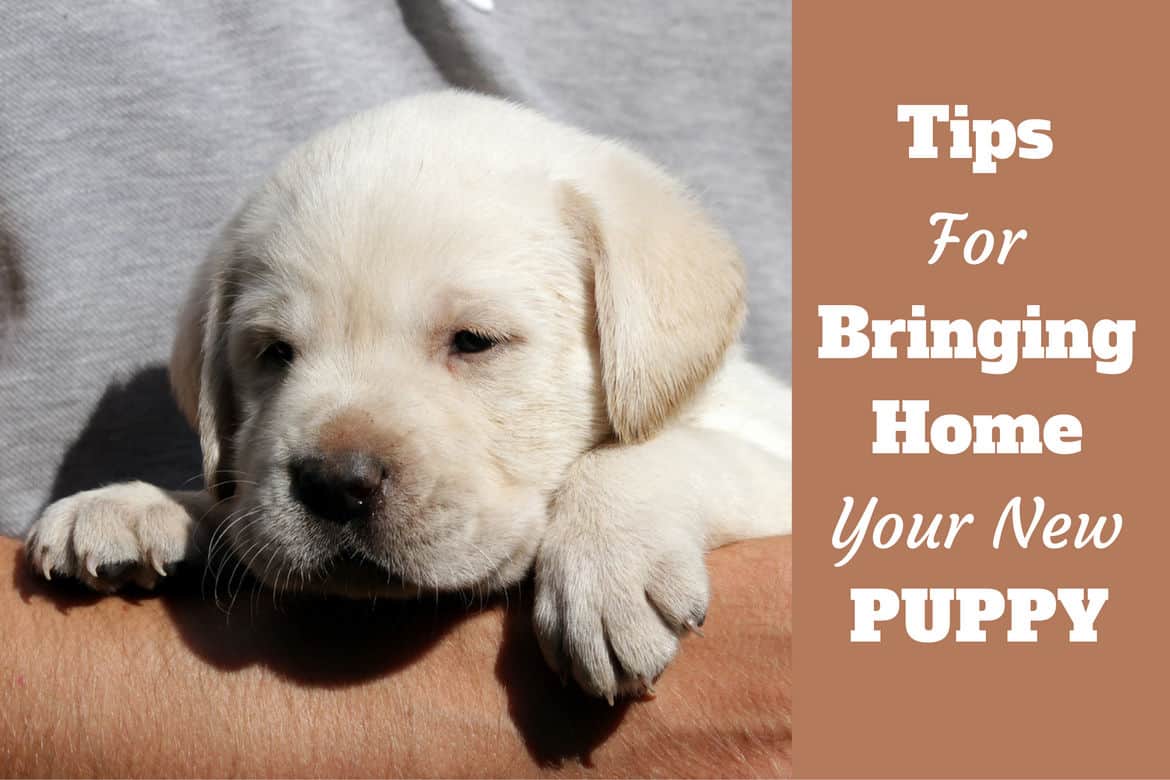
Leaving behind their mother, litter-mates, first human family and only small part of the world they’ve ever seen, there’s no doubt that going to a new home is a major day in a puppy’s life, with potential to be highly stressful.
But not only for them as it’s a life-changing time for you too!
Without preparation, bringing home a new puppy can be a difficult and challenging time, but there are many things you can do to help things run more smoothly.
In this article we discuss:
- How to prepare for a new puppy
- How to ready your home in time for their arrival
- Tips for the journey home
- Recommendations for when you first arrive
- What to expect and do in the first 24 hours
- How things progress from there.
For first time puppy owners there are so many questions need answering on how to prepare for those first few precious days and that is the aim of this article.
It’s a lot to cover but extremely important too! So let’s begin…
Contents & Quick Navigation
- Preparing Your Home For A Puppy
- Collecting Your New Puppy
- What To Do When First Arriving Home
- What Behavior Can You Expect The First Day?
- What Can You Expect From Day 2 And Beyond?
- Feeding A New Puppy: What, How Much, How Often And At What Times?
- Where Should A New Puppy Sleep?
- Do Not Give Your Puppy Full Run Of Your Home
- How And When To Start House Training Your Puppy?
- When To Start Crate Training A Puppy?
- When To Start Training A New Puppy?
- When Should You Start Socializing Your Puppy?
- When Should You Take Your New Puppy To The Vet?
- Final Thoughts On bringing Home A New Puppy
- Further reading:
- Top Picks For Our Dogs
Preparing Your Home For A Puppy
You should treat the preparation of your home for the arrival of a new puppy in much the same way as you would for the arrival of a baby because the process is almost identical.
You must be ready to provide every little thing your puppy needs in life, making sure they have water, are fed, comfortable, happy, catered for and safe.
To achieve this there are 4 main things that you need to do:
- Go shopping for equipment and supplies
- Puppy proof your home and garden to make sure your puppy stays safe
- Set up an area for your puppy to sleep and spend time in when you cannot supervise them
- Decide on the rules and routines required to successfully raise a puppy
Without such preparation, things will be difficult. So let’s go through each of these 4 areas one by one so you know exactly what you need and have to do:
Go Shopping For New Puppy Supplies
You’re going to need a fair amount of essential equipment and supplies to take care of your new puppy. Therefore, long before the big day, make sure you’ve stocked up on the following essential items:
QUICK RECOMMENDATION: Our friends at Puppy In Training have an extensive new puppy checklist including all the products and supplies they buy for their service dog puppies in training.
A Nutritious Puppy Food
The most important supply needed for a new puppy is a highly nutritious puppy food.
Hopefully your puppy came from a responsible breeder who was feeding them a high quality, complete and nutritious food. If so, you should ask what they were feeding, stock up on and continue feeding this if possible.
If not, then puppies are incredibly active, growing fast and developing bone, muscle and more every day.
Because of this they need almost double the calories, more protein and have different nutritional needs to mature adult dogs.
Furthermore, they have far smaller mouths than adult dogs so puppy food comes in smaller chunks more suited to their size.
Therefore, don’t feed your puppy food that’s made for adult dogs, make sure you buy one specially formulated for puppies.
Click here to see our recommendations for the best puppy food for labs
Bowls for Food And Water
There is a bewildering array of dog bowl choices out there so choosing the best can be difficult.
Looks and design aside, I recommend going for stainless steel bowls because they are long-lasting, cannot be chewed and are very easy to clean.
I also recommend buying bowls with heavy rubber bottoms so they stay rooted to the spot and are harder to spill or flip over. Unless of course you buy bowls in a stand, then these problems are already solved.
A Puppy Crate And Bedding
A good crate is one of the most beneficial things you can provide for the good of yourself and your puppy.
It speeds up the house training process, keeps your puppy safe and out of mischief when you can’t watch over them, provides a place for them to escape to for relaxation when they wish…and many more good reasons besides.
I’ve written a detailed guide to the benefits and use of a crate that you can see by clicking here:
Why Use a Dog Crate – and Is It Cruel to Crate a Dog?
You will also need to add some accessories to the crate for comfort and security.
First of all, supply some bedding to place inside for your puppy to sleep on. My recommendation for this is VetBed.
Many puppies can chew and ingest normal bedding which can result in medical emergencies and VetBed is the most durable bedding on the market.
Once you know they won’t chew their bedding, you can change to something more plush and stylish of your choice.
A Puppy Exercise Pen And Pet Barriers
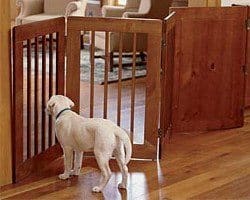
It’s all but guaranteed you will need to leave your puppy alone at some stage for longer than they can be fairly crated.
During these times you need to provide a larger, but still safe enclosure to confine your puppy.
You cannot allow your puppy free-run of your entire home, otherwise you’ll find they potty, chew and otherwise cause havoc all over it, causing damage and putting themselves in danger.
What I and many others do is confine their puppy to a single room by placing a pet barrier / baby gate across an entrance to confine them to one room, or you can buy and set up an exercise pen to safely hold them.
Make sure if you use a gate that your puppy can’t squeeze through, and if you use an exercise pen make sure it’s too high for them to jump over and out.
You might also like to buy a plastic sheet and some puppy pads (or use lots of old newspaper) for them to use as a potty in your absence.
Puppy Chew Toys
Puppies chew. A lot. And they seem to prefer chewing phones, footwear and TV remotes more than anything else.
All jokes aside, to prevent damage to your possessions you’ll want to provide toys for them to chew on and actively direct all their chewing on to these toys.
The best puppy chew toys on the market, strong and durable which is particularly important for Labrador’s, are Kong Toys.
You can use them ‘as-is’, but you can also stuff them with kibble, food treats, peanut butter or even frozen yogurt to make the toy interactive and keep your puppy’s mind occupied and happy.
Just make sure whatever toys you do buy are suitable for a puppy as many will be too large for their little mouths to begin with.
Interactive Puppy Toys
So you can play games with your puppy, provide exercise and mental stimulation, you will want to buy a few toys that encourage the two of you to interact.
Balls for throwing and chasing, soft toys and ropes for playing tug, other toys for fetch, there are many available. Be sure to grab a few that will enrich your puppy’s life.
Cleaning Supplies
Your puppy will have numerous ‘potty training’ accidents over the first few weeks. And if they can smell in an area that they’ve been there before, it attracts them back for a repeat performance.
So be prepared with an enzymatic, odor neutralizing cleaner that’s specially formulated to completely remove all traces of urine and pet stains.
QUICK RECOMMENDATION: We’ve been using Puppy In Training Stain & Odor Eliminator for all of our puppy messes.
Collar And Leash
You will need to buy a good leash and collar so you can keep your puppy safely under your control when out on a walk, also so you can lead them to their bathroom spot and keep them there to do their business instead of wandering off and forgetting what they’re outside for.
You can see our guides here for ‘How To Choose The Right Collar‘ and ‘How to Choose the Right leash‘.
You will also need a collar to provide a place to attach an all important ID tag.
ID Tag
An ID tag is an essential means to be reunited with your puppy should the worst happen and you somehow lose them or they run away. They’re also required by law in many places in the world.
So buy a good, durable ID tag, have engraved upon it your address, ZIP / postal code, your phone number and optionally you can include your puppy’s name if you wish.
For a list of recommended ID tags, please check our Best Dog ID Tags blog post.
Clicker
A clicker is an extremely useful tool used during training as a reward marker that dramatically improves the timing of communication between you and your puppy when you want to reward a behavior.
Although not essential, I do highly recommend you use one.
For an introduction to the use of event markers in training and to see if it’s something that you might want to use, please see the following article:
What Is A Clicker And What Are The Benefits To Using One?
Puppy Training Treats
Tasty food treats are the go-to reward used during training so you will want to make sure you always have a good stock at hand.
Whether or not you decide to clicker train your puppy and need to pair a food reward with the marker, you will still want to have some treats available because Labrador’s especially are highly food motivated and you need to have something for them to work for during training.
Check out some of the best and our favorite dog training treats.
Grooming Tools
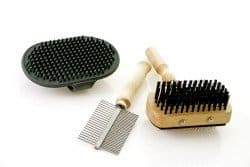
Grooming is a fantastic way to relax and bond with your puppy and even though they won’t need it, you should fake going through the process anyway.
You need to get your puppy used to being touched all over because you’ll be doing yourself, the vet and any groomers you employ in future a massive favor!
They need to feel happy with being bathed, happy having their coat and teeth brushed, their feet touched, nails clipped and having their eyes and ears inspected.
To do so, you should fake going the process, getting them used to being handled, the sight and feel of the tools and so on.
To achieve this, you will need to buy and get them used to the following items:
- Dog shampoo
- Combs and brushes suitable for a Labrador
- Scissors
- Nail clippers
- Cotton balls
- Toothbrush
Use these tools right away and often, and give your puppy praise and tasty treats as you go so they form positive associations with grooming.
You want to get them happy and accepting of being handled and touched all over while a puppy, before they become a strong adolescent or adult when it becomes extremely hard to control them if they’re determined.
Puppy Proof Your Home and Garden
The process of puppy proofing your home is very much like baby proofing before the arrival of a child. Except a puppy is far more curious, active and destructive and can get themselves into far more trouble.
A puppy is a new-born. They’re completely naïve and clueless about the world around them, what’s safe and what isn’t and will explore and play with everything and anything until they’re taught to know better.
Everything is a toy and they will run and pounce and jump and chew on anything in their environment. It’s cute to see, but can also be very dangerous.
So before you bring your puppy home you simply must make it safe for them.
As a brief summary, you want to pay attention to removing everything that’s at puppy level such as electrical cords, low hanging curtains or fabrics, remote controls, footwear, things on end tables and low surfaces, plants, magazines and books – anything and everything they can get their paws on must be removed or made safe.
For things you cannot move (skirting boards, table legs etc.) spray them with a bitter-tasting chew repellent to discourage any chewing.
For a detailed guide to help you in the puppy proofing process, please see the following article: How To Puppy Proof Your Home And Garden
Create An Enclosed Safe Area For Your Puppy To Play And Sleep In
You shouldn’t let your puppy have free roam of your home because they may potty everywhere and likely get into lots of trouble and even danger.
To keep them safe while still providing an area for them to play in and stretch their legs, you want to restrict their access to a single room, or otherwise create an enclosed space for them.
To do so, either buy a pet barrier or baby gate that goes across a doorway to restrict them to an easy to clean and safe room, or buy an exercise pen (puppy pen) to create an enclosed space in another room.
I also strongly recommend buying a crate for many reasons, but initially, mostly just to provide the perfect place for them to sleep. I shall discuss crate training a little later in this article.
Decide And Set The Rules And Routines – For Your Puppy And Everyone!
Puppy’s need food, water, toilet breaks, training, sleep, play and exercise, preferably at the same times every day because they get used to and thrive on routine.
They also need a set of rules to live by such as where you allow them to go, what they’re allowed to do, how rough they can play, what they can chew on, what they can’t, and many more rules besides.
It’s especially important to discuss all this if there’s more than just you in your household so that everybody knows, understands and sticks to the same rules, as well as knowing who will do what for the puppy and when.
All of this must be decided BEFORE you get your puppy home because consistency is a key part of raising a puppy successfully. Everyone must enforce and live by the same rules for your puppy to thrive.
Initially they have no idea how you want them to behave, or how and when they can expect the things they want and need in life.
The more consistent everybody is with the puppy, the quicker they will learn all this stuff and the happier everyone will be.
So decide and write down if necessary when your puppy will have all their needs met, make sure everybody knows who is responsible for each task and make sure everybody knows the rules.
I’ve written an article to help guide you in this process that you can read by clicking the following link:
Set Some House Rules Before You Get Your Puppy Home
Collecting Your New Puppy

So the big day has arrived! You might think the collection and journey home with your new puppy is no big deal, but there are many things can go wrong.
Especially if you’re collecting them from some distance away, you will need some preparation as I’ll soon describe below.
But before I get to advice for the journey home, let’s quickly discuss the age at which you should collect them.
How Old Should A Puppy Be Before You Bring Them Home?
It’s essential for a puppy to stay with their mother and litter-mates for the first 7 weeks MINIMUM of their life, but it’s universally agreed that 8 weeks is best. Therefore, you should never take a puppy before 8 weeks old.
If you’re offered a puppy before this age, you can bet your bottom dollar that the breeder isn’t responsible so you should probably look elsewhere.
During the first 8 weeks, a puppy learns a lot from their mother and litter-mates: Bite inhibition, canine body language, acceptable play and interaction with other dogs and how to accept discipline.
Things you will find it very hard to teach them later yourself.
The flip side of this is that the 7 to 14 week stage is the most impressionable for a puppy, where they bond strongest with people and must be socialized to all the sights, sounds and smells of the world so they grow up confident and comfortable with their surroundings.
You really want to be a part of this process to make sure it’s done correctly.
So collect your puppy when they’re 8 weeks old, 7 weeks at an absolute push if it’s unavoidable, but never before.
You can read more on this subject in my article: What is The Best Age To Bring A Puppy Home?
Preparing For The Journey Home
The ride home is all about safety, minimizing stress and catering to your new puppy’s needs.
You have to expect some crying and whining because it’s a highly stressful time for your puppy. So don’t get worried or annoyed, it’s perfectly normal.
And if you’re going to be on a journey of any distance, ask the breeder if they can make sure your puppy has an empty stomach for the journey.
This will reduce the chance of travel sickness…or other ‘messy accidents’ in the car!
So anyway, for the journey home there a few things you need to consider: Safety in the car, the need for water and toilet breaks and the possibility your puppy will be sick.
Let’s take a look at each of these in turn:
Car Safety During The Ride Home
If you’re driving home alone, placing your puppy in a crate is the best of all your options.
Having a loose puppy in the car presents a very real danger of leading to a crash, they can easily climb out of a box and now is not the time to use a harness and car safety belt.
If the crate is small enough you can place it on a front or rear passenger seat and secure it with the seat-belt, or you may have to place it in the trunk of your car.
Fully line the crate with absorbent paper in case there are any accidents, this will keep most of the mess off your puppy and make cleaning easier.
And finally, place a chew toy or two in the crate to keep your puppy occupied. They will likely ignore it and cry, but it’s definitely worth a shot!
If you have another person to help you, your puppy can ride home in their lap if the journey is short. Though if longer, it’s best you use a crate and the puppy can go between the two: The crate and their lap.
If your puppy is to sit on a passengers lap, it’s vital that you attach a collar and leash.
They will almost certainly hate this as they won’t yet be used to it, but puppies are extremely wriggly and you cannot afford any chance of the puppy breaking free and getting between your foot pedals! They must be under your passengers control.
The Need For Water And Toilet Breaks
If it’s a long journey, your puppy will need water along the way. They will also need to potty every half or so. It’s a good idea to combine these two events as a puppy usually needs to wee very soon after drinking.
Therefore, you should plan breaks along the way every 30 minutes or so. Stop the car, allow them to drink, then wait for them to wee before setting off again.
When you stop, make sure your puppy is on leash and tightly held by someone before letting them out of the car. A puppy can easily bolt in a panic as they won’t know what’s happening and may be scared.
Also when you stop, make sure it’s not in a place frequented by other dogs as your puppy will not have had their vaccinations yet.
And as an extra precaution, carry your puppy and only put them down to do their business, then carry them back into the car.
Your Puppy May Get Travel Sick

Some puppies get travel sick during their first journey in a car so you should prepare for this.
Take with you some towels, plastic bags, kitchen roll and deodorizer to take care of any accidents.
And when driving, take all corners slowly, and accelerate and brake gently.
If you’re on your own, your puppy will be a in a crate and the only thing you can do is to line the crate thickly with highly absorbent paper and make a few stops on the way home to check and change the crate lining.
If your puppy is on a passengers lap, they will be able to see some warning signs that puppy is about to be sick: Their lips will curl, they will excessively salivate and then eventually start to heave.
When your passenger spots these signs, they can place a thick towel beneath the puppy to catch everything and avoid a mess in your vehicle.
Finally, Go Straight Home, No Faffing Around!
When bringing home a new puppy, make sure you collect them and then drive straight home.
Your puppy is having the most stressful day of their short life so far, try not to make it harder than it already is by taking them to strange places and passing them around to strangers to say hello.
You want to get them home quickly so they can start the process of settling in as soon as possible.
What To Do When First Arriving Home
The very first thing you want to do is carry your puppy straight to the place you’ve chosen as their bathroom spot.
Whether this is inside on paper, or a spot outside, as soon as you arrive home carry them there, set them down and wait for them to do their business before doing anything else.
This might take 30 seconds or it might take 10 minutes, but patiently wait and when they go, praise them profusely. Well done! You’ve just started house training by getting off on the right foot.
And then it’s time your puppy got to explore the place that’s now their new home and to meet their new family.
Shut Away Other Pets, Make Sure All People Are Calm
If you have other pets, now is not the time to introduce them. Shut them in another room away from the puppy as things are intense enough as it is.
Of course, every person in the house will be excited and eager to say hello right away, but make sure beforehand you’ve instructed everyone to remain calm and quiet.
It’s especially important that you give instructions to children who can easily frighten your puppy if they get over-excited. Explain they have to be calm and gentle during the first introductions.
Put Puppy Into Their ‘Free-Play Zone’ And Let Everyone Say Hello
After coming out of the car and their first toilet break, put your puppy into the enclosed room or exercise pen you’ve set up as their safe area and free play zone.
Let them sniff and look around, getting used to the area and their new little world.
You can now let people come and say hello.
They should step into the puppy’s area and get down to the puppy’s level so they’re less intimidating. Have people sit or kneel to greet them.
And let your puppy explore and go to them, don’t have people running over and scooping puppy up, this may frighten them.
Once everybody has said hello, you should stay with your puppy, show interest but stay calm. Your puppy needs time to adjust and relax into their new world which won’t be easy if everybody is over-excited.
Keep them in the little puppy zone you’ve set up. There’s no need to show them all the bedrooms and cubby holes of your home, there’s plenty of time over the coming months to break them into the rest of your home.
Allow Your Puppy To Sleep
After all the excitement, stress, massive change and huge amount of mental stimulation your puppy has just been through, they will likely need to sleep soon after arriving at your home.
So as soon as they either start to look tired, or the introductions to their new living space and family have ended (whichever comes first) put them to bed for a short while. They’re going to need it.
What Behavior Can You Expect The First Day?

They might speed round like a little hurricane, sticking their nose into every little thing they can, yapping, bouncing and playing hyperactively.
On the other hand they might feel completely overwhelmed, retreat into themselves and show reluctance to explore.
They might slink into a corner silently and sit there watching their new world with wonder but apprehension, before falling asleep for hours.
And when it comes to the first night they might sleep right through, or they might cry and whine the whole night.
There’s just no way of knowing so expect to see either extreme or anything in between and just accept that it’s perfectly normal.
After raising over a dozen Service Dog puppies our friends at Puppy In Training have seen the best and worst of a puppy’s first night home.
What Can You Expect From Day 2 And Beyond?
As your puppy begins to get used to everything, their character will start to shine through and you will begin to see their true personalities.
Exactly what this will be is different for every puppy…it will be fun for you to find out!
And by being the provider of everything they need in life, giving them all that is good, it will only take 2 or 3 days for your puppy to learn to love you and get excited and happy to see you when you turn up.
Also, by following rigid schedules for feeding, play and potty breaks as described earlier, it will only take a few days for your puppy’s body clock to fall into a routine.
So your task is to set up and stick to these schedules, begin training your puppy and help them to learn how you want them to behave and when they can expect the things they need in life.
Feeding A New Puppy: What, How Much, How Often And At What Times?
What you feed your puppy will have possibly the biggest effect on their overall health and development so it’s something as a responsible owner you just have to get right.
What should you feed your puppy
You should feed your puppy the same food they had at the breeders because an abrupt change in diet almost always leads to stomach upset.
If you’d like to or must change their diet, do so a week or more later, slowly and carefully, making sure it’s a ‘complete and balanced‘ highly nutritional food designed for puppies.
Complete and balanced means it has everything a puppy needs, and in the right quantities. So seek out this kind of wording and check the internet for other owners reviews.
How Much Should You Feed Your Puppy?
Puppies need to eat a lot because their rate of growth is very high. But you shouldn’t feed them too much because being overweight is bad for their health.
Generally speaking, you should follow the quantity guidelines that came with your dog food, then adjust how much you feed depending on your puppy’s body condition.
You shouldn’t be able to see their ribs, but with light pressure you should be able to feel them. If you can see them, increase their rations, if you can’t feel them then reduce their rations.
How Often Should You Feed Your Puppy?
For puppies up to 12 weeks, you should divide their daily requirement into 4 portions, for puppies 12 to 26 weeks, feed them 3 times per day and from 26 weeks on feed them twice per day.
You should also aim to feed them as close as you can to the same times every day and evenly spaced throughout the day.
This will help their body clocks fall into a pattern and will help your house training immensely because they then potty the same times every day.
For example:
- 8 to 12 weeks old, 4 times a day at 7:30AM, 11:30AM, 3:30PM and 7:30PM
- 12 to 26 weeks old, 3 times a day at 7:30AM, 1:30PM and 7:30PM
- 26 weeks old and ongoing, 2 times a day at 7:30 and 6:30
Obviously you can adjust these times to take into account when you get out of bed and to fit around your life.
Where Should A New Puppy Sleep?

Without doubt the best thing for your puppy to sleep in is a crate.
If you’ve decided you’re not going to use one with your puppy…please reconsider. If you’re absolutely sure, then at least make sure to use an exercise pen and provide a dog bed.
Your puppy should be confined at night because there’s too much mischief and danger they can get up to otherwise. Also…
The first few nights have the crate or exercise pen your puppy sleeps in placed in your bedroom.
The fact your puppy knows you’re there will comfort them and help ease the pain of the transition of going from sleeping with their mom and litter-mates to sleeping entirely alone.
If they’re forced right away to sleep alone in another room, there is a far higher chance of them crying and whining all night through a feeling of complete abandonment.
I’ve also heard it said that if your puppy can see you sleeping, they learn from you that night-time is for sleeping and not for waking activities. Whether true or not I don’t know, but it does make some sense.
After the first 3 to 4 nights, if you’re not going to have your dog sleep in the bedroom with you, my advice is not to simply move them to their final sleeping place right away, but to start moving them there slowly.
One night move the crate next to the bedroom door. The next night move it outside the door, but leave the door open so they can still see you. The next night further into the hallway. Finally to their eventual resting place.
They might take to sleeping on their own OK, they might whine and cry.
NEVER go to them to comfort them if they cry, you must only get up to take them to potty and then silently and without fuss put them back into the crate.
You mustn’t let them think that noise gets you to come. Rewarding silence and ignoring noise is the only way they will eventually learn to be quiet at night themselves.
Do Not Give Your Puppy Full Run Of Your Home
Puppies explore the world with their mouths so a puppy should never be allowed unsupervised run of your home, it’s just too much responsibility.
Any time you cannot closely supervise them, you have to confine them, either in their crate, an exercise pen or a puppy proofed room secured with a barrier across the doorway.
The point of confining them as a puppy is so they can enjoy all the freedom in the world once they are an adult.
When confined, the things they can chew are completely under your control and you can make sure it’s only ever on appropriate things.
By confining them with treat dispensing chew toys they get rewarded for chewing the right things and develop a chew toy obsession.
The alternative of letting them free in your home where they can chew shoes, remotes, curtains and furniture won’t only be frustrating and expensive for you, but if they discover these things are good to chew on it will be extremely difficult to train the habit out of them later.
Confine them now, they form a good chew toy obsession and have no chance of developing bad chewing habits.
Then once they are over their adolescent chewing stage you slowly open up the house to them and eventually they can have free roam and be completely trusted. A little sacrifice when young for a better life later.
And a second hugely important reason for confining your puppy when you cannot supervise them is for speedier house training.
How And When To Start House Training Your Puppy?

You should start house training from day one. In fact if you read my comments from earlier, you will see you start the very first moment you finish the journey home.
In essence, house training is about creating good habits while avoiding bad ones and for the speediest success you want to start immediately.
Wherever your puppy is able to potty has the chance of becoming their favored toilet spot for many weeks or months to come. So you want to prevent them pottying inside, and encourage them to potty outside.
The main ingredients of a successful house training program are preventing mistakes and praising heavily for doing the right thing. Achieving this is all about schedules, supervision and confinement.
Now, your puppy will need to potty anywhere from every 15 to 45 minutes. So to start with, take them outside every 30 minutes and adjust this schedule to suit their natural rhythm.
You must also take them outside immediately after they wake up from any sleep, after any eating or drinking, after play and after any heightened excitement.
These are times that often lead to a puppy needing to potty so take them outside at these times and you will avoid many mistakes while taking advantage of predictable opportunities to praise them for doing the right thing.
In the first week or so, you will likely find your puppy almost instantaneously leaks with little warning. There is little you can do about this and it’s not their fault, so just accept and expect it.
Simply do your best to take them out to potty extremely often so they go in the right place as often as possible. And confine them to a single enclosed room or in an exercise pen for the first week or so to protect your carpets.
I’ve written an extremely comprehensive guide to house training that you can read by clicking the following links:
A Definitive Guide To House Training (lots of theory and different techniques)How To House Train A Puppy (cuts to the chase with the best methods)
When To Start Crate Training A Puppy?
Crate training goes hand in hand with house training, being one of the best tools to help speed up the process.
Therefore, you want to start crate training very early on, after just a few days of getting puppy home, and I personally aim for 9 weeks old to start.
I prefer to wait a week or so to avoid them pottying in the crate as much as possible, doing the most I can to preserve their instinct not to soil where they sleep, the instinct that helps most when using a crate for house training.
But by all means sleep them in their crate at night if you wish (and I do.) Being in a crate at night isn’t the same as ‘crate training’, particularly if you scoop them up asleep and place them in their crate.
For more information on crate training your puppy and using it for house training purposes, please see the links below:
- A Complete Guide To Crate Training
- How To Crate Train Your New Puppy
- How To Use A Crate To Speed Up House Training
When To Start Training A New Puppy?
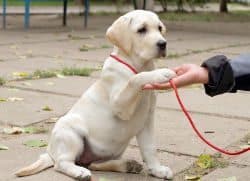
One of the joys of modern, reward-based positive training techniques is you can start to train your puppy at any age because it’s so gentle.
So why not start right away?
Young puppies learn at a phenomenal rate and are eager to do so. Additionally it provides mental stimulation, physical exercise and quickly strengthens the bond between the two of you. It’s extremely fun as well!
So start training your puppy any time after the first 3 or 4 days home, once your puppy has settled in and found their feet.
You may well hear some people saying you should wait a few weeks.
You might even hear from some traditional trainers you should wait for 6 months! But if you want to give your puppy the best chance of fitting into this modern human world, starting right away is definitely best.
For a more detailed read on when to start training your puppy, why and what you can train them, please read the following article:
When Should You Start Training Your Puppy?
When Should You Start Socializing Your Puppy?
Socialization is the process of introducing your puppy to as many sights, smells, sounds, people, children and animals as possible, while making every experience as pleasant as you can.
You do this to teach your puppy to be happy and confident in every environment and in any situation that life can throw at them.
Without socializing your puppy when young, they can grow up lacking confidence and be fearful of certain objects, sounds, people or places. So you can see why it’s a vitally important process?
Socialization for your puppy actually started way before you even got them home, but it’s your duty to carry it on from day one. Yes, right away from day one.
But bear in mind that for the first day or two you don’t have to do much as they’re being socialized to all the new sights, smells and sounds in their new home.
You just have to try to make the experiences they’re already having as pleasant as possible.
However, once you’ve had your puppy for a couple of days, you should start on a well planned out program of socialization.
For a good overview of puppy socialization please see my article: What Is Puppy Socialization? Why Is It So Important?
For more detailed information on socialization, please see the following 3 articles:
- How to socialize your puppy – From Karen Pryor clicker training
- Socializing your puppy – From the ASPCA
- The puppy socialization website – An extensive resource with step-by guides, worksheets and even a tracker you can fill in to keep a log of your progress!
Please, really do read them, it’s so important you get socialization right!
When Should You Take Your New Puppy To The Vet?

You should take your puppy to see the vet within the first week of getting them home, on the 4th or 5th day is ideal, after 7 days at the latest.
However, some breeders require that you take them to the vet within 72 hours as part of your contract for taking the puppy.
They make this part of the agreement so they can learn if there is anything wrong with any of their litter and be able to notify the other puppy owners. So you may have to follow this 72 hour rule.
Now, you might have read some people advise to take your puppy the minute you get them, on the first or very next day.
But this isn’t the best advice as you won’t have had a chance to assess their behavior and spot any signs or symptoms of any problems, something your vet will ask you about.
Also, many puppies will have stomach upset after such a drastic change as a move to a new home. This might clear up after a day or two and you (and your vet) will want to know if this is the case.
The reason you take your puppy to the vet within the first week home is so they can check for any birth defects, any hereditary disorders or abnormalities, and any internal or external parasites.
It helps if you take a stool sample along to the first vet visit for this purpose.
Final Thoughts On bringing Home A New Puppy
Bringing home a new puppy is an extremely exciting time, but it does have the potential to be stressful for you and your puppy.
A little preparation before the day goes a long way to making the whole experience as pain-free as possible. So it’s highly recommended you get a lot of little things ready and in place before you go to collect them.
Prepare for the journey home, make sure you have puppy supplies at the ready, decide upon the new house rules and decide on all the puppy care routines so everybody in your home knows who has to do what and when.
Prepare a crate and a ‘safe-zone’ in the form of an enclosed room or an exercise pen so you have some short and long-term confinement options, for house training purposes and to keep your puppy and your home safe when you cannot supervise them.
Finally, study up on and develop house training, crate training, obedience training and socialization programs to begin right away so your puppy can hit the ground running in their new life with you.
Preparing properly for the coming home of your puppy will ease them into their new life as seamlessly as possible and set you both on the road to a fantastic life together.
I hope my new puppy tips have been of some of help!
Further reading:
If you’d like some further reading, I highly recommend this excerpt of a book from ‘TheDogStarDaily’ that covers a puppy’s first days at home, house training, crate training, puppy classes, bite inhibition and much more besides.
It’s a long read…but a very good investment of that time!
Raising A Puppy – From DogStarDaily
Save To Pinterest
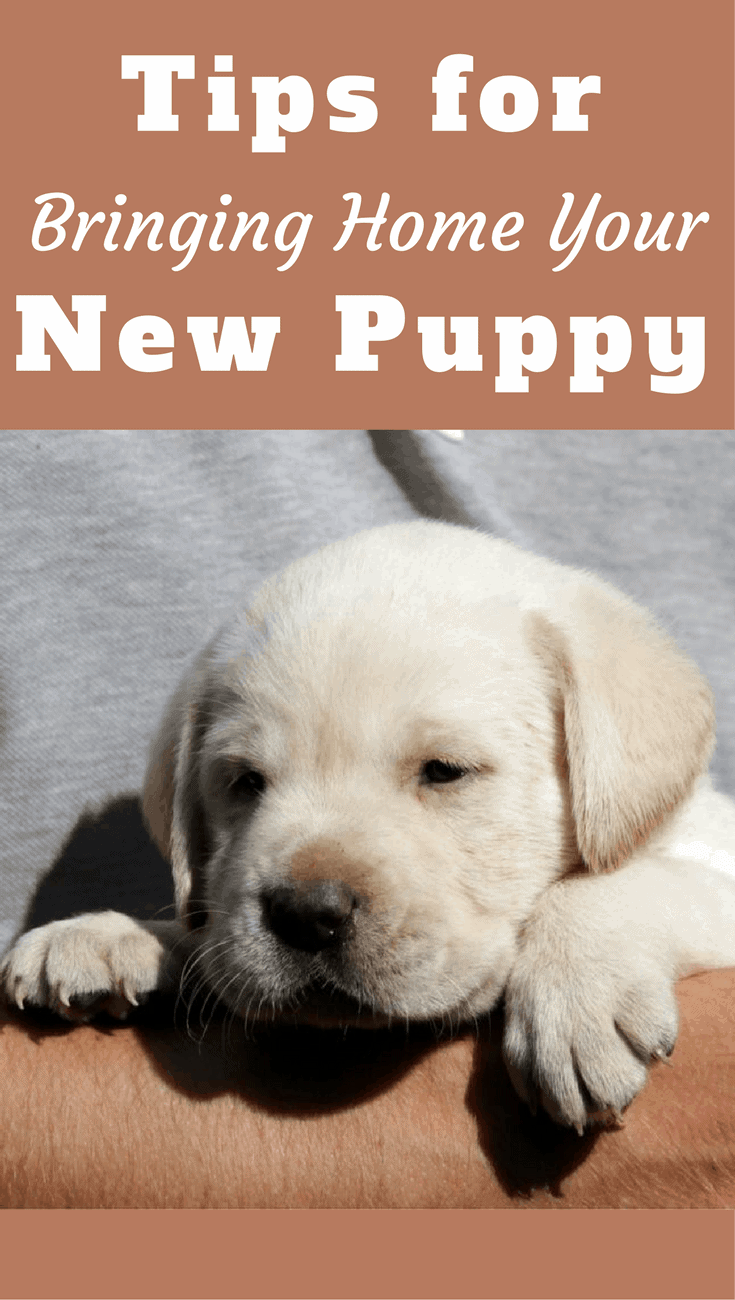
Top Picks For Our Dogs
- BEST PUPPY TOY
We Like: Calmeroos Puppy Toy w/ Heartbeat and Heat Packs - Perfect for new puppies. Helps ease anxiety in their new home. - BEST DOG CHEW
We Like: Bones & Chews Bully Sticks - All of our puppies love to bite, nip, and chew. We love using Bully Sticks to help divert these unwanted behaviors. - BEST DOG TREATS
We Like: Crazy Dog Train Me Treats - One of our favorite treats for training our service dog puppies. - BEST FRESH DOG FOOD
We Like: The Farmer's Dog - A couple months ago we started feeding Raven fresh dog food and she loves it! Get 50% off your first order of The Farmer's Dog.
For a list of all the supplies we get for our new service dog puppies check out our New Puppy Checklist on the PuppyInTraining.com blog.
10 comments
Hello Mark,
Excellent articles, they’re very informative and useful, however I have a ton of questions about a female lab pup that I will be getting in 6 weeks. This is a gift for my brother, and we are going to be first time pet owners with 0 experience :/. The expertise you possess about lab dogs is beyond amazing and we need your help immediately. Can you please msg me via email, its much appreciated.
Thank you.
Hi Gary,
Sure, e-mail sent, check your inbox.
Hi, so I went through many articles here and please I need an advice as I do not seem to get it…you say, if one decides to crate train, to do it very slowly, take the time etc but you also say to put the puppy to the crate right when you pick him up from the breeder. We will be picking puppy up in 2 months and it is a 5 hr drive home. I do not wish to use the crate, only very occasionally, so would you please advise me how to transfer him home in a car safely without scaring him by placing him in a crate (it is gonna be my hubby me and my 3 year old)? or if the crate is necessary, what can we do in order to make it easier on him? thank you, I LOVE your website!!!
Hi Petra,
If you were to pick up your puppy alone, my advice is to crate him / her. An awake puppy doesn’t stay still for very long and if you are alone, it is very unsafe as they could crawl onto and distract you while driving, get into the space between the foot pedals…you know how that could end! So the lesser of two evils between the puppy not liking it or you crashing the car, you should keep them and yourself safe and crate them for the journey.
However, if you have a partner with you…as you do…there’s no need to use a crate, he can simply hold the puppy in his lap. Preferably with a collar and leash on so he has full control and the puppy cannot escape into your foot well between the pedals. Or he could sit with the puppy in a high-ish walled box on the back seat and keep an eye on the puppy this way. Your puppy will take this better, it will be less stressful.
Choice is yours really :-)
Hi Mark!
I sent you an email but I also would love to comment here. I am a dog person and lived with dogs most of my life, when I was growing up with my aunt we had a Dog and I missed having one. However, I now live by myself and I am going to get a dog for the first time which is just mine and mine alone.
The thing is, because I wanted to be prepared i stumbled on your site and saw other things that I would never have considered. I’ve already reserved the dog and there’s no going back. I was wondering if you have some tips for me?
I work at night and my work demands work schedule changes without any warning. I’m much willing to play with my new dog and provide for all her needs, I may not have the space she needs but I am near the park and can walk her everyday or most of the time if not. But I would have issues regarding consistency and schedules. I’m so excited but I’m also scared that I might not be able to house train her or keep her happy most of the time.
Please help!
Hi lin,
It’s going to be difficult in many ways I think..but not impossible. However, I’m afraid I’ve never been in this position so haven’t advice to give from experience. Having said that…
First of all, House training will be difficult, it will still be possible it will just take longer without solid routine. I think you’re going to have to set up an area with an indoor toilet at first, then house train religiously when you are home and awake. Check out my articles on paper training and house training for advice there.
Secondly, I would recommend joining 3 or 4 large dog forums and posting a well worded question there explaining your situation and asking for the advice of others who have been or are in the same position as you. Literally google ‘dog forum’ and open the first 20 results, then pick 3 or 4 of the busiest, join them and post the same question to each. Apologies in advance for some of the answers you’ll get – they may not all be friendly, but hey, that’s the internet! However, in the answers you WILL get some very good advice from people with experience of your situation. Def worth a try :-)
Third, do you have neighbors, friends, family, or teenage sons and daughters of friends you trust who can help in a small way or perhaps are looking to earn some pocket money? Having somebody else pop by at routine times for walks, exercise and play, maybe feeding and so on will go a long way toward helping. Someone to come in and walk your dog while you sleep the morning? Or of course a professional dog walker, there are usually a few in every town and city and they aren’t too expensive. beneficial, even if used just two or three times per week.
Finally: Could you take a couple of weeks holiday to at least help your pooch settle in and start some routine? Kickstart learning and be dedicated for 2 weeks at least before resuming haphazard schedules? This would surely help.
This is about all I can say I’m afraid and I really do recommend the forum idea: Join and ask in 3 or 4 forums to get a wide collection of advice and opinions from many people, then apply your ‘common sense’ filter to all the replies and go from there.
Are you making the right choice getting a puppy in your situation? This is the fear I have of some of the forum responses being negative…but you can appear anonymous of course! In my opinion, yours isn’t the best life situation to get a puppy as you’re well awre. However, the fact you have asked, the fact you are seeking out info and advice, the way you come across, it sounds to me you will be very caring and are willing to work hard to do the best by your new family member. Just do your best to stick to some sort of routine where you can, do your best at other times and I’m sure things will work out. I’m sure your dog will feel loved and can have a fulfilling life with some effort.
Good luck and all the best,
Mark.
(FYI: I replied to your e-mail but delivery failed and I got this message in return: ‘The following organization rejected your message: AVEXCHETS02.startek.local.’ I will delete the other two comments posted after this one as they are duplicate :-) )
Hi Mark,
Great info! Thanks!
My husband and I are going to our home town for holidays, we will be staying in our family cabin for a week with our new puppy and then flying to our (now) own city.
Any advice surrounding flying with a lab puppy? I am worried the trip might be traumatic.
Thanks again!
-Liz
Hello Liz
First visit your vet to ensure the pup is de-wormed three days prior to flying and that he has had his vaccinations. Choose the right pet carrier for him, one that can fit under the seat. A little crate training at home may help him feel comfortable during the flight. put a chew toy in with him.
find out what your airline offers for pet travel
Have a fun filled Vacation
To your Pup’s good health
Cheers
My boyfriend and I are getting a puppy but I am wanting to be prepared for when we bring him home. It’s good to know that the day that we bring him home that there are different things that he might do that we should remember, like how he might sleep through the night or he might cry and whine the whole time. This will be great to know so that we will be able to be aware of things that might happen and able to work through it.
Hello, yeah this paragraph is really pleasant and I have learned
lot of things from it concerning blogging. thanks.